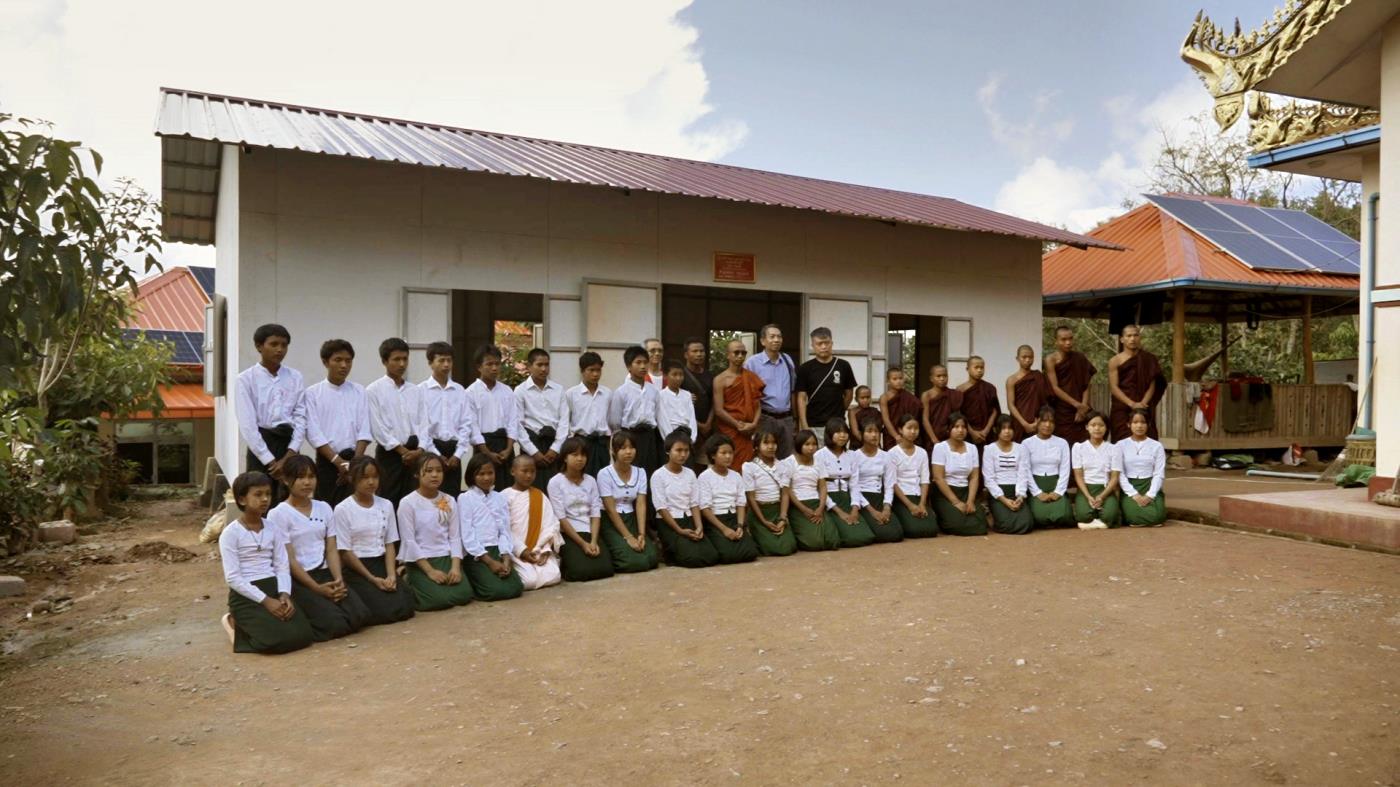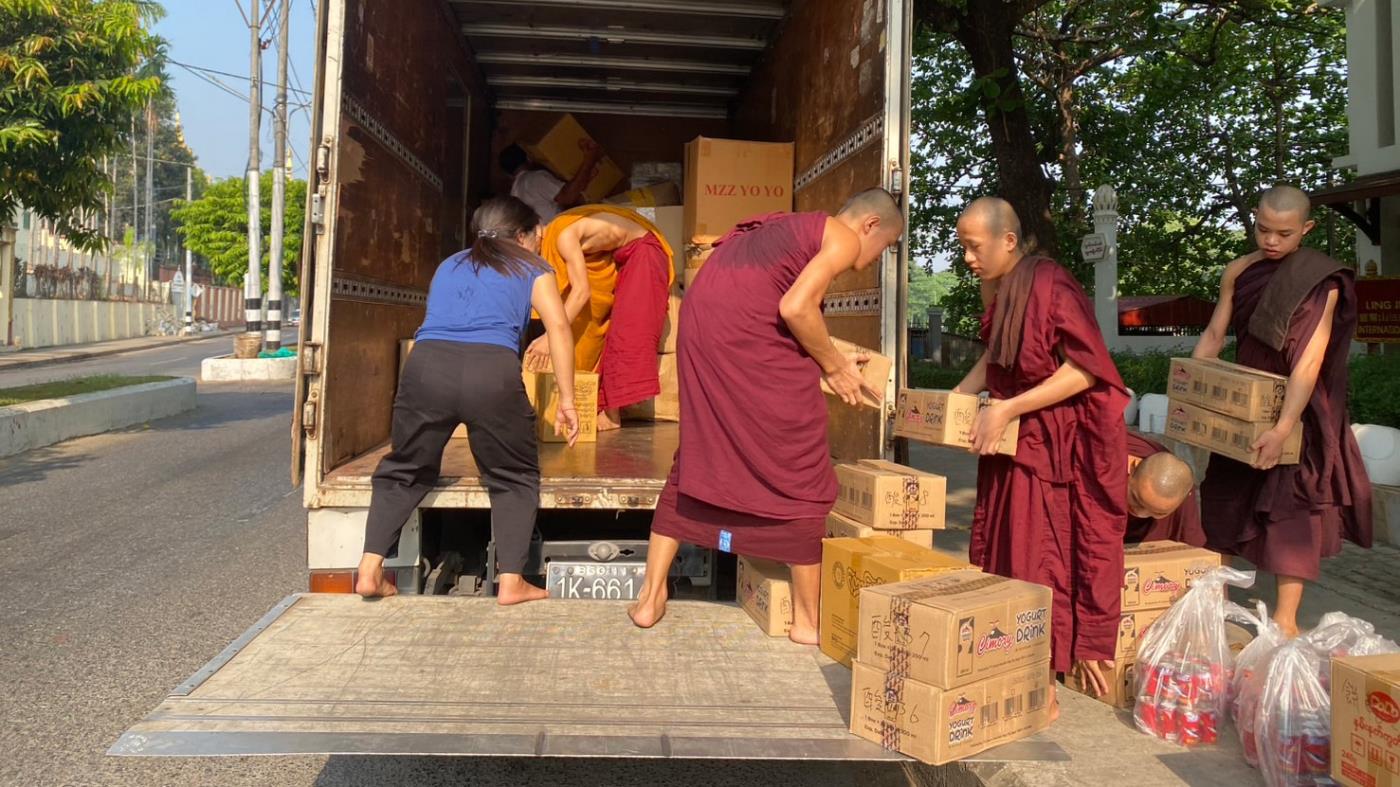From Ruins to New Beginnings: Localization towards Sustainability of Ling Jiou Mountain's Relief Mission to Myanmar














The magnitude 7.7 earthquake that hit Myanmar in 2025 is fading into oblivion, while the large-scale crushing and tumbling of civilian houses, school campuses, temples, and shrines left many locals devastated in shambles, their livelihoods for long-term stability mercilessly wiped out. Grand Master Hsin Tao said that 'the nature of disaster relief goes far beyond materialistic support to substantiate emotional solace and psychological rebuild'. Guided by that directive, the Ling Jiou Mountain Buddhist Society (LJM) has been dispatching long-term relief missions to disaster-stricken areas to build pre-fabricated housing units, to bring life-supporting materials to disaster survivors, to offer daycare and after-school programs for children, and to help concretely in rebuilding temples and shrines for communities wherever feasible. Central to all LJM missions is the desire to help restore normalcy for families affected by chipping in to the fundamentals of their new beginnings.
For housing reconstructions in many disaster-stricken areas, such as Yauag Aung Min Village near Naypyidaw, LJM rebuilt with pre-fabricated modular units to help families in regaining normalcy as soon as possible. A 62-year-old local woman, Daw Than Than Htay, expressed gratitude by stating: "This is not just shelter from the wind and rain, but the future of my child," while adding that the modular housing ensures her 12-year-old granddaughter's schooling goes on unaffected and after-school tutoring is accessible as well.
Bhikkhu Ashin Sandawbar Tha, who once taught at the LJM Maha Kusala Yama Monastery Sramanena Orphan School at Naung Mon, Myanmar, is another local helping disaster-hit communities. Together with his mother, Daw Nu Nu, they offered privately owned land lots for free leasehold to families to rebuild homes in their original neighborhood. Such deeds manifest how people help one another in post-disaster times. As many schools scaled back on campus sizes due to quake damage, LJM made efforts to help school children maintain their progress in studies by visiting schools and offering stationery and scholarships.
Venerable Jing Nian, Superintendent of the LJM International Meditation Center in Myanmar, pointed out that the core principles of any LJM rebuild lie in housing safety, living stability, and education. Grand Master Hsin Tao's motto of 'creating limitless possibilities with limited resources' continues as a guidepost for any and all LJM post-disaster rebuild.
Deputy Dean of the LJM Maha Kusala Yama Monastery Sramanena Orphan School, Myanmar, Venerable Heng Ming, accompanied local monastics and laity to conduct field surveys and coordinate relief missions for the hardest-hit areas, such as Sagaing and Mandalay. He also supported international cooperation by adopting the LJM pattern of localization as follows.
The first thing LJM and local volunteers did was to assess resources while recording/reporting damages and casualties. LJM then coordinated to modify housing units made of retired containers that a fellow Buddhist institution (Fo Guang Shan) provided, and retrofitted them as modular sets for quick assembly to resolve the urgent housing need that better suited local needs for ventilation and other climate considerations.
Furthermore, LJM is cooperating with organizations such as the Community Partners International (CPI) and The Chung-Hwa International Merits Society of Buddha-puja and Sangha-dana. They plan to build additional modular units in two regions and integrate them with the Naung Mon Eco-Farm to offer job opportunities, thereby promoting the gradual self-reliance of the victims.
A Mandalay resident, Lae Lae, was helping out at the frontline to take down people's requests for modular housing units. She prioritized seniors who had nowhere to turn. And all that, even though her own 3-storey house suffered severe damage. She delivered a shining example of humanity and embodied the value of community members helping one another in times of stress.
Another focal point of LJM's reconstruction efforts is the renovation of damaged temples and shrines, as well as the care associated with the buildings being reconstructed. The Zayar Shwe Bone Temple, located in the suburbs of Naypyidaw, saw half of the walls of its second-floor prayer chamber collapse, urgently requiring repairs. LJM offered the funding for repairs immediately, with Venerable Jing Nian calling on the abbot to present the funding support to facilitate the restoration so that a repaired temple resumes its function as the spiritual beacon for the community.
Damage to other temples and houses of worship was just as severe. The Htut Myat Aung Myae Temple in Sagaing had been a two-floored building that collapsed entirely in the quake, with only two lavatories standing, and the 27 precepts practicing Bhikkuhnis had only thatched shelters in the open. The abbot was grateful that children under their care were spared, as the walls crumbled outward. She clasped her hands in gratitude for the stress relief coming their way and said that 'we had nowhere to turn to, if it were not because of the support from fellow Buddhist communities.' Her remark reaffirms how critical outside help can be in times of stress to help stabilize communities and extend the power of faith.
Post-quake reconstruction continues to weigh heavily, but LJM remains dedicated to restoring homes, temples, and education, together with local monastics and citizens, to help victims regain a firm footing on their way to new beginnings. The efforts go beyond repairing damaged constructions towards stabilizing communities in times of stress to continue the strength of faith. LJM is committed to continuing its reconstruction efforts and accompanying every victim who needs support, ensuring the light of faith shines once again amid the rubble and challenges.
For housing reconstructions in many disaster-stricken areas, such as Yauag Aung Min Village near Naypyidaw, LJM rebuilt with pre-fabricated modular units to help families in regaining normalcy as soon as possible. A 62-year-old local woman, Daw Than Than Htay, expressed gratitude by stating: "This is not just shelter from the wind and rain, but the future of my child," while adding that the modular housing ensures her 12-year-old granddaughter's schooling goes on unaffected and after-school tutoring is accessible as well.
Bhikkhu Ashin Sandawbar Tha, who once taught at the LJM Maha Kusala Yama Monastery Sramanena Orphan School at Naung Mon, Myanmar, is another local helping disaster-hit communities. Together with his mother, Daw Nu Nu, they offered privately owned land lots for free leasehold to families to rebuild homes in their original neighborhood. Such deeds manifest how people help one another in post-disaster times. As many schools scaled back on campus sizes due to quake damage, LJM made efforts to help school children maintain their progress in studies by visiting schools and offering stationery and scholarships.
Venerable Jing Nian, Superintendent of the LJM International Meditation Center in Myanmar, pointed out that the core principles of any LJM rebuild lie in housing safety, living stability, and education. Grand Master Hsin Tao's motto of 'creating limitless possibilities with limited resources' continues as a guidepost for any and all LJM post-disaster rebuild.
Deputy Dean of the LJM Maha Kusala Yama Monastery Sramanena Orphan School, Myanmar, Venerable Heng Ming, accompanied local monastics and laity to conduct field surveys and coordinate relief missions for the hardest-hit areas, such as Sagaing and Mandalay. He also supported international cooperation by adopting the LJM pattern of localization as follows.
The first thing LJM and local volunteers did was to assess resources while recording/reporting damages and casualties. LJM then coordinated to modify housing units made of retired containers that a fellow Buddhist institution (Fo Guang Shan) provided, and retrofitted them as modular sets for quick assembly to resolve the urgent housing need that better suited local needs for ventilation and other climate considerations.
Furthermore, LJM is cooperating with organizations such as the Community Partners International (CPI) and The Chung-Hwa International Merits Society of Buddha-puja and Sangha-dana. They plan to build additional modular units in two regions and integrate them with the Naung Mon Eco-Farm to offer job opportunities, thereby promoting the gradual self-reliance of the victims.
A Mandalay resident, Lae Lae, was helping out at the frontline to take down people's requests for modular housing units. She prioritized seniors who had nowhere to turn. And all that, even though her own 3-storey house suffered severe damage. She delivered a shining example of humanity and embodied the value of community members helping one another in times of stress.
Another focal point of LJM's reconstruction efforts is the renovation of damaged temples and shrines, as well as the care associated with the buildings being reconstructed. The Zayar Shwe Bone Temple, located in the suburbs of Naypyidaw, saw half of the walls of its second-floor prayer chamber collapse, urgently requiring repairs. LJM offered the funding for repairs immediately, with Venerable Jing Nian calling on the abbot to present the funding support to facilitate the restoration so that a repaired temple resumes its function as the spiritual beacon for the community.
Damage to other temples and houses of worship was just as severe. The Htut Myat Aung Myae Temple in Sagaing had been a two-floored building that collapsed entirely in the quake, with only two lavatories standing, and the 27 precepts practicing Bhikkuhnis had only thatched shelters in the open. The abbot was grateful that children under their care were spared, as the walls crumbled outward. She clasped her hands in gratitude for the stress relief coming their way and said that 'we had nowhere to turn to, if it were not because of the support from fellow Buddhist communities.' Her remark reaffirms how critical outside help can be in times of stress to help stabilize communities and extend the power of faith.
Post-quake reconstruction continues to weigh heavily, but LJM remains dedicated to restoring homes, temples, and education, together with local monastics and citizens, to help victims regain a firm footing on their way to new beginnings. The efforts go beyond repairing damaged constructions towards stabilizing communities in times of stress to continue the strength of faith. LJM is committed to continuing its reconstruction efforts and accompanying every victim who needs support, ensuring the light of faith shines once again amid the rubble and challenges.

